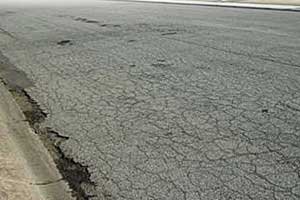Rural roads could become bumpier and narrower, and darkness
could descend on city streets if Governor Arnold Schwarzenegger’s
proposal to take local gas tax funds becomes a
”
devastating
”
reality.
Rural roads could become bumpier and narrower, and darkness could descend on city streets if Governor Arnold Schwarzenegger’s proposal to take local gas tax funds becomes a “devastating” reality.
Local governments are scrambling for a way to make up for crucial losses to their road maintenance budgets, while state assemblymembers seek solutions that generate equivalent dollars without straining cities and counties. The governor’s proposal is changing by the day, according to Santa Clara County employees, but it would entail the state taking up to $1.9 billion that would normally be divvied up among counties and cities. The money would be used to help close a $24 billion state deficit going into fiscal year 2010.
Local governments use those funds for regular street repairs, maintenance and improvements, and in some cases, the funds comprise the bulk of annual street works budgets. About 80 percent of Santa Clara County’s roads and airports budget is funded by the state-levied transportation taxes the governor has proposed to dip into, according to Roads and Airports Department Director Michael Murdter.
Two tax funds – the Highway Use Tax Account and Proposition 42 gasoline and diesel tax – are projected to bring about $37.4 million in revenue to the county department next year, Murdter said. The governor’s plan, which has no set reimbursement schedule, would deny the county about $29 million.
“That is a devastating impact,” Murdter said. “We’re working on a contingency plan, but it’s difficult to compensate for that magnitude of revenue loss.”
The county already faces a $273 million deficit in its general fund going into next year.
The roads and airports department is in charge of maintaining about 650 miles of roads in unincorporated parts of the county, Murdter said. That includes pothole repairs, vegetation abatement, striping, sign installation and traffic signal upkeep. About 60 percent of county roads are in the southern part of the county.
“We would most likely have to defer a significant portion, if not all of our planned road maintenance work” if the department’s budget is cut by 80 percent next year, Murdter said.
The county would probably still be able to staff crews that respond to pothole repairs, such as team that smoothed out a crevasse on Dewitt Avenue west of Morgan Hill last week. However, a delay in major improvement projects and a lengthening of the unincorporated roads’ regular 10-year resurfacing schedule, as well as minor maintenance such as street sweeping, would be among the more noticeable impacts of the state takeaway.
But the effect of the governor’s proposal also depends on how long the funds would be diverted, and whether or not the state would pay local departments back, Murdter said.
Those details are not yet known, and the proposal has changed almost daily since it was first announced last week. Over the weekend, Schwarzenegger said if both political parties opposed to the plan, it likely would not pass. However, he sent the proposal to the legislature anyway.
Local assemblymembers are opposed to the taking of gas tax funds, and have begun to confer on alternate proposals such as raising other taxes, and spending cuts that grow deeper with each discussion.
Gilroy Mayor Al Pinheiro is not excited about the idea of the state holding onto money for local street repairs. The city is already struggling with a $4.7 million deficit going into next year, after laying off dozens of employees and dipping into its reserve funds earlier this year.
That deficit doesn’t count what “the governor and his buddies” might take not only through the gas tax proposal, but potential scenarios that could be laid out in the coming weeks such as a diversion or borrowing of property taxes, he said.
“If the governor takes $1.2 million (for example), we would have to go into our reserves,” Pinheiro said. “Local governments have enough issues as it is. We’re trying to keep our safety units in place. Employees have taken furloughs and cuts, and no raises to try to mitigate some of these impacts.”
Shifting away local gas tax revenues to pay for state debt would be “unfortunate,” added Assemblymember Anna Caballero of the 28th district, which includes Gilroy. But she said such a takeaway would be “routine” for the state.
“I have sat as a city council member and a mayor and felt for a long time that the state has to enact reforms that are necessary to eliminate takeaways,” Caballero said.
Caballero also supported imposing unspecified fees or taxes to raise revenue, she said.
She said the state has dug a hole for itself by approving billions of dollars in debt spending over the years. “Now, we’re going to make some very ugly, very deep cuts, but not take from local governments,” Caballero said.












